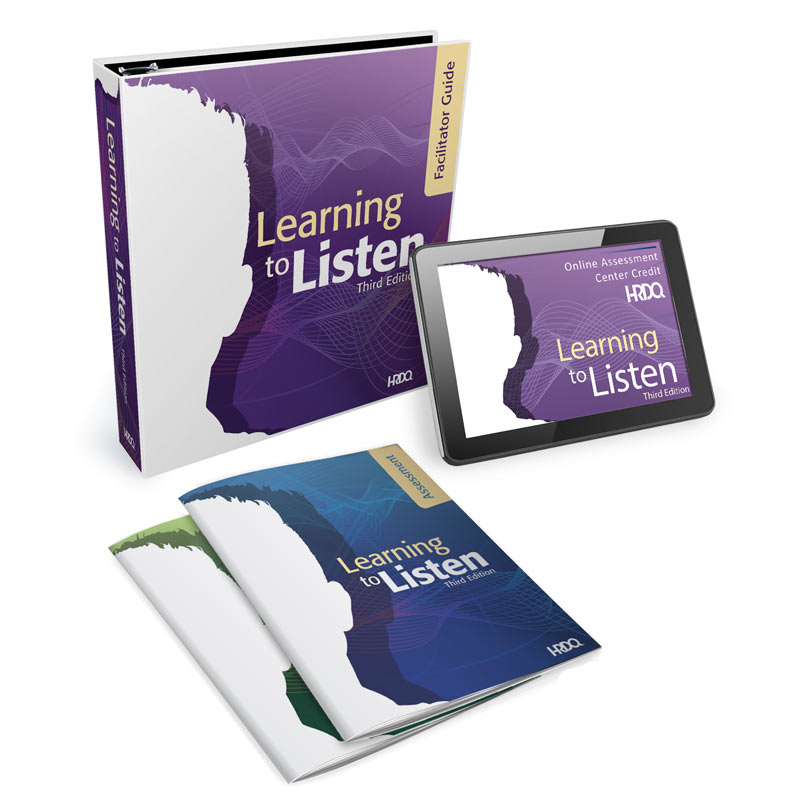LEARNING TO LISTEN

by Laurie Ribble Libove, MS and the HRDQ Development Team
Available in both Online and Paper-Based Format
If you want to make real improvements to communication, it's time to listen up.
Learning to Listen is the communication training tool that will help you to achieve immediate, lasting results. Whether you are looking for an instructor-led program or a self-paced learning option, this combination self-assessment, workbook, and classroom workshop offers a comprehensive yet flexible solution that improves active listening skills.
It's been a trainer favorite for more than 15 years, and Learning to Listen has just been substantially enhanced! From background information and improved statistical reliability to preparation and facilitation guidelines, the Third Edition offers everything you need to get up to speed quickly and deliver a successful training experience, including a fully revised, full-color facilitator guide, a participant workbook , new online assessments, a self-study option, support materials, audio-based practice activities, and so much more.
Why is Learning to Listen so effective?
With a focus on both visible and invisible aspects of listening behavior, Learning to Listen evaluates current skill level, shows individuals how to take an active role in the listening process, and then provides ample opportunities for practice and development. The result? Employees who are well equipped to handle customer complaints, negotiate contracts, perform as team members, and lead departments. And that translates into a competitive advantage for your organization.
Learning Outcomes
- Determine listening effectiveness in three dimensions
- Explore the visible and invisible aspects of listening
- Learn what it takes both physically and mentally to listen
- Understand common barriers to effective listening
- Create a plan to put new skills into immediate action
The Learning to Listen self-assessment is available in both online and printed formats. Using one-on-one conversations as a frame of reference, individuals respond to a series of 30 statements, choosing from a five-point scale of Almost Always to Almost Never. Results reveal an Overall Listening Effectiveness score as well as subscores in three dimensions: Staying Focused, Capturing the Message, and Helping the Speaker. The inventory takes approximately ten minutes to complete and we recommend you allow about an hour for the interpretation of results.
In addition to the self-assessment, the Learning to Listen Facilitator Set includes all the tools you need to lead a half-day classroom workshop, from comprehensive background information and step-by-step instructions to a professional Microsoft® PowerPoint® presentation, skill practice exercises, and development planning. Trainer certification is not required to administer or facilitate Learning to Listen.
The Third Edition also offers online assessment options for both individual users and self-study learning that feature a personalized, comprehensive interpretation of results plus the Listening Model, a review of responses, and development exercises to help improve performance.
Uses and Applications
Learning to Listen is appropriate for all individuals, but it's especially useful for supervisors, managers, customer service representatives, sales professionals, consultants, negotiators, and anyone who spends a significant amount of time in a listening role. It can be used as a stand-alone communication assessment, the centerpiece of a soft-skills training program, or part of a more comprehensive curriculum on topics such as:
- Communication
- Performance Coaching
- Customer Service
- Needs Assessmen
- Selling Skills
- Supervising
- Negotiating
- Giving and Receiving Feedback
Target Audience
All individuals
It's especially useful for supervisors, managers, customer service representatives, sales professionals, consultants, negotiators, and anyone who spends a significant amount of time in a listening role.
Product Type
Self-assessment and classroom workshop
Measures
Three dimensions of effective listening
Dimensions
Staying Focused
Capturing the Message
Helping the Speaker
Time Required
Administration: 10 minutes
Interpretation: 1 hour
Workshop: Half-day (optional)